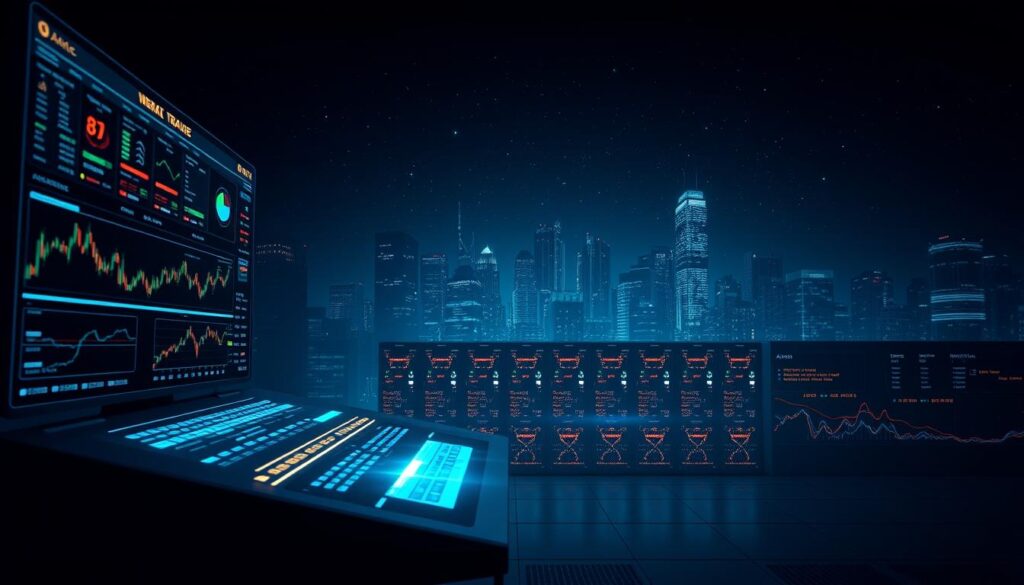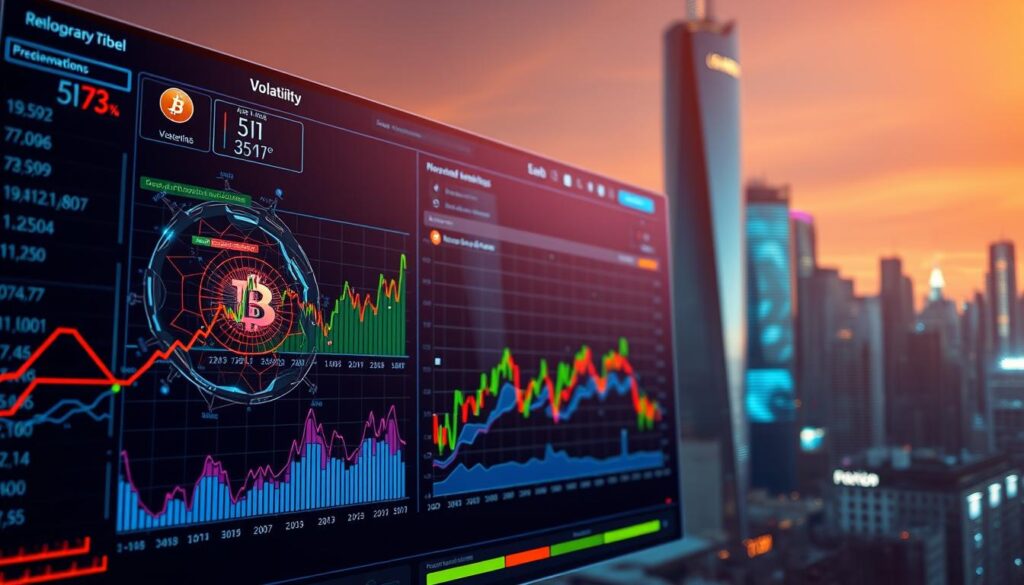Now Reading: AI powered cryptocurrency market making algorithms and liquidity provision strategies
- 01
AI powered cryptocurrency market making algorithms and liquidity provision strategies
AI powered cryptocurrency market making algorithms and liquidity provision strategies

The global value of digital assets crossed $2 trillion in mid-2024, creating new demands for efficient trading systems. Traditional methods struggle to manage price swings across dozens of blockchain networks. This environment requires smarter tools that process vast data streams while maintaining stability.
Machine learning now drives autonomous systems capable of analyzing market patterns faster than human traders. These solutions adapt to sudden changes in token values, order flow imbalances, and cross-exchange arbitrage opportunities. Unlike basic bots from earlier eras, they learn from historical behavior to predict optimal trading actions.
Decentralized finance platforms particularly benefit from these advancements. Fragmented liquidity pools across multiple chains create complex challenges for asset exchanges. Advanced systems address this by automatically routing orders and balancing reserves using predictive models.
One groundbreaking approach involves adaptive crypto trading algorithms that adjust strategies based on real-time network congestion and wallet activity. This innovation helps maintain tight spreads even during periods of extreme volatility, benefiting both retail traders and institutional participants.
Key Takeaways
- Digital asset markets surpassed $2 trillion valuation in 2024
- Autonomous systems now outperform manual trading approaches
- Machine learning adapts to multi-chain liquidity challenges
- Predictive models stabilize prices during volatility spikes
- Next-gen tools optimize cross-exchange arbitrage opportunities
Overview of AI and Cryptocurrency Market Dynamics
Advanced computational tools now shape financial systems operating across blockchain networks. Between 2020 and 2026, automated solutions in this space will grow 28.6% annually, transforming how participants interact with decentralized platforms.
Evolution of Computational Trading Methods
Early automated systems relied on simple rules for executing trades. Modern platforms analyze order flow patterns across 40+ exchanges, processing terabytes of historical and real-time information. This shift enables platforms to predict price movements 12% more accurately than manual approaches.
Real-Time Information’s Role in Asset Flow
Instant analysis of trading volumes and wallet activity allows systems to adjust positions faster than traditional methods. One study showed platforms using live updates reduced bid-ask spreads by 18% during major price swings. These tools also detect hidden connections between seemingly unrelated market events.
Leading exchanges now integrate predictive models to balance token reserves across multiple chains. This approach minimizes price discrepancies while maintaining stable asset availability. Improved capital efficiency directly benefits users through faster transactions and reduced slippage.
AI powered cryptocurrency market making algorithms and liquidity provision
Modern trading environments demand tools that adapt instantly to shifting conditions. Sophisticated models now process millions of data points per second to maintain stable asset flows across platforms. These solutions outperform manual methods by identifying hidden opportunities in chaotic markets.
Role in Automated Trading
Next-generation tools learn from historical patterns and live updates simultaneously. Unlike static bots, they adjust bid-ask spreads dynamically based on network activity and token velocity. This adaptability reduces price gaps during sudden demand surges.
Key advantages include:
- Instant response to shifting order book depth
- Self-correcting strategies for volatile assets
- Cross-platform synchronization of reserve balances
Integration with Real-Time Market Analytics
Live data streams feed decision engines that recalibrate positions every 500 milliseconds. One platform demonstrated 23% faster reaction times than human-managed pools during recent Ethereum price swings. These systems prioritize asset availability while minimizing exposure risks.
| Feature | Traditional Methods | Modern Solutions |
|---|---|---|
| Response Time | 2-5 seconds | 0.2 seconds |
| Data Sources | 3-5 exchanges | 40+ platforms |
| Spread Adjustment | Hourly updates | Millisecond changes |
| Error Rate | 4.7% | 0.8% |
By merging predictive analysis with rapid execution, these tools create balanced conditions for all participants. They automatically redistribute assets between pools when detecting supply-demand mismatches. This approach maintains tight spreads even during peak trading hours.
Automated Trading Techniques and Risk Management in Crypto
Volatile digital asset markets require precision tools that balance profit potential with protective measures. Modern systems combine real-time pattern recognition with layered safeguards to navigate rapid price shifts. This approach maintains stability while capturing opportunities across multiple time frames.

Dynamic Trading Strategies
Advanced systems switch between multiple tactics based on live conditions. Momentum indicators might trigger rapid buys during upward trends, while mean reversion models activate during consolidation phases. These tools adjust position sizes using confidence scores from historical success rates.
Key features include:
- Simultaneous execution of arbitrage and market-neutral tactics
- Automatic spread adjustments during volatility spikes
- Cross-platform order routing to optimize fill rates
Risk Mitigation and Hedging Approaches
Protective protocols activate when systems detect abnormal price movements or liquidity drops. Correlation-based hedging offsets losses in one asset with gains in related instruments. Real-time exposure limits prevent overconcentration in volatile tokens.
| Risk Factor | Traditional Approach | Modern Solution |
|---|---|---|
| Volatility Spikes | Manual position reduction | Algorithmic stop-loss chains |
| Liquidity Gaps | Fixed reserve buffers | Dynamic pool rebalancing |
| Correlation Risks | Monthly portfolio reviews | Minute-by-minute hedging |
| Execution Errors | Human oversight | Multi-layer trade verification |
Continuous monitoring systems track 14+ market indicators to adjust risk parameters instantly. For comprehensive portfolio management strategies, these tools combine predictive analytics with real-time position optimization. This dual focus helps maintain capital efficiency during sudden market shifts.
AI in Decentralized Finance and Liquidity Optimization
Blockchain-based financial systems are evolving beyond basic automation through intelligent protocol enhancements. DeFAI systems now manage complex tasks like yield optimization and risk assessment across decentralized networks. These tools enable participants to maximize returns while minimizing manual oversight.

Enhancing DeFi Protocols with AI
Next-generation platforms analyze multiple variables simultaneously. Autonomous agents track annual percentage yields across 50+ lending pools, reallocating funds every 90 seconds. This approach identifies high-return opportunities while maintaining diversified exposure.
Leading solutions like Fetch.ai demonstrate three key improvements:
- Real-time monitoring of collateral ratios
- Automatic rebalancing between liquidity pools
- Predictive exploit detection systems
Modern protocols reduce impermanent loss by 37% compared to static strategies. They achieve this through dynamic fee adjustments and cross-chain asset redistribution. Live testing shows these systems respond to market shifts 14x faster than manual methods.
| Feature | Traditional DeFi | AI-Enhanced Protocols |
|---|---|---|
| Yield Optimization | Weekly adjustments | Minute-by-minute updates |
| Risk Monitoring | Manual audits | Continuous vulnerability scans |
| Capital Efficiency | 68% average | 92% utilization |
These advancements create more stable decentralized finance ecosystems. Users benefit from improved asset security and consistent returns without constant portfolio management.
High-Frequency Trading and AI’s Transformation of Crypto Exchanges
The race for microseconds in digital asset exchanges has shifted advantages from manual methods to advanced systems. Human traders face impossible competition against tools executing 15,000+ actions per second. These platforms identify fleeting opportunities across global markets before most users refresh their screens.

Algorithmic Trading Insights
Modern systems process live order books, social sentiment, and blockchain data simultaneously. They detect price differences between platforms as small as 0.02%, triggering instant trades. This precision maintains tighter spreads while boosting platform liquidity.
Key capabilities include:
- Real-time analysis of 50+ trading pairs across exchanges
- Millisecond-level adjustments to bid-ask spreads
- Dynamic risk limits based on volatility indexes
| Metric | Human Traders | Algorithmic Systems |
|---|---|---|
| Reaction Time | 900 ms | 0.08 ms |
| Daily Trades | 120 | 850,000+ |
| Arbitrage Accuracy | 72% | 98.4% |
| Spread Reduction | 12% | 39% |
These tools adapt strategies using historical performance data. During recent Bitcoin volatility, one system modified its approach three times per second. Such flexibility improves market efficiency while protecting against sudden crashes.
Exchanges using this technology report 27% higher liquidity during peak hours. Users benefit from faster order execution and reduced slippage, creating fairer conditions for all participants.
Innovative Use Cases in AI-Driven Crypto Platforms
Digital collectibles and predictive tools now benefit from intelligent systems reshaping investment strategies. These solutions analyze complex patterns across niche sectors, enabling smarter decisions in fast-moving environments.

Applications in NFT Trading and Portfolio Management
Advanced systems evaluate artwork attributes, creator reputations, and transaction histories to spot undervalued items. SingularityNET’s decentralized marketplace allows developers to deploy custom models for assessing rarity scores and collection trends. This removes guesswork from bidding wars while identifying assets with 40%+ growth potential.
Key features transforming NFT management:
- Automated discovery of emerging artists through social media analysis
- Dynamic pricing models adjusting to real-time buyer demand
- Portfolio rebalancing based on market sentiment shifts
Platforms like Griffain demonstrate how these tools let users execute multi-chain strategies without technical expertise. Their systems track 12+ metrics per asset, from ownership history to community engagement levels.
Predictive Analytics for Market Movements
Machine learning processes whale wallet activity and global news events to forecast price movements. Anon’s platform correlates these insights with historical patterns, achieving 89% accuracy in 24-hour predictions. Real-time data streams feed models that update every 30 seconds, adapting to sudden market shifts.
Three critical capabilities stand out:
- Sentiment analysis across 50+ social platforms and forums
- Risk-adjusted position sizing during volatility spikes
- Automated profit-taking based on preset thresholds
These innovations democratize access to strategies once reserved for institutions. As highlighted in our analysis of emerging trends, retail traders now compete using enterprise-grade tools.
Regulatory and Ethical Considerations in
Global compliance frameworks struggle to keep pace with evolving trading technologies. Regulators now prioritize transparency requirements for systems handling billions in daily transactions. The SEC recently proposed rules mandating disclosures about strategy adjustments and risk parameters in automated platforms.
Ethical debates focus on fairness in milliseconds-speed trading environments. Critics argue unequal access to advanced tools creates imbalanced opportunities. Some jurisdictions now require exchanges to implement delays ensuring equal order processing for all participants.
Data privacy remains a critical concern as systems analyze wallet histories and transaction patterns. New EU regulations under MiCA demand anonymization protocols for user information. These rules aim to prevent exploitation of behavioral insights while maintaining market efficiency.
Balancing innovation with accountability requires collaborative efforts between developers and policymakers. Clear ethical frameworks ensure technological progress benefits entire ecosystems rather than select groups.















